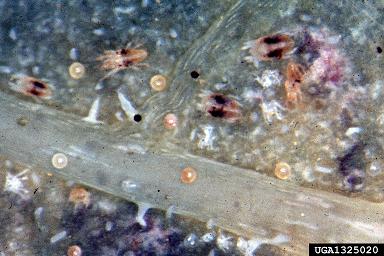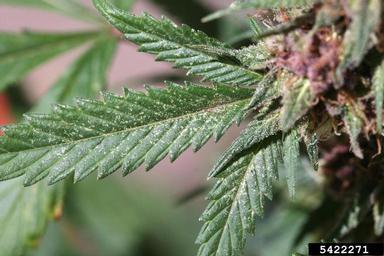Overview
Scientific Name
Tetranychus urticae
Type
Arthropod, arachnid
Damage Appearance
Leaf wilting, speckling and yellowing
Season
Pre-harvest, harvest
Cropping System
Greenhouse and field
Sampling and Thresholds
Twospotted spider mites can be observed on leaves using at least 10x magnification either with a hand lens or microscope. Mites can be directly observed on leaves, or multiple leaves can be observed by using a mite brush.
As industrial hemp is a relatively new crop in North Carolina, no research has been done to determine the threshold for concern. Further investigation is needed since hemp is grown for different markets (i.e. fiber, seed, CBD).

Multiple life stages of twospotted spider mite.
Whitney Cranshaw, Colorado State University, Bugwood.org CC BY 4.0
Biology
The twospotted spider mite (TSSM), Tetranychus urticae, can occur in both indoor and outdoor industrial hemp production. TSSM are highly polyphagous and can feed on hundreds of plants, including most vegetables and field crops. They thrive in high temperatures and low humidity, and under ideal conditions can complete a generation in 1-2 weeks. This short life cycle leads to multiple, overlapping generations in short periods of time which can cause extensive damage.
Female TSSM are larger (0.4 mm) than males. Both sexes range in color from pale yellow to bright green. There is usually a pair of large dark spots on the sides of the body, but some may have two pairs of spots. Females typically lay up to 200 spherical eggs on the underside of leaves, and eggs are roughly half the size of adult females. Eggs hatch one to two days after being laid, and a six-legged larva emerges. The larva then molts into an 8-legged nymph which in turn molts two more times before becoming an adult.
TSSM overwinter by slowing their metabolism and becoming semi-dormant. Once in this diapause state, the color changes to an orange-red. This overwinter period is triggered by shortened days (less than 10 hours of light) or cooler temperatures.

Hemp plant covered with webbing from twospotted spider mites.
Whitney Cranshaw, Colorado State University, Bugwood.org CC BY 4.0
Damage in Industrial Hemp
Twospotted spider mites are extremely polyphagous, which increases its ability to move between crops and fields. It feeds on plant cell contents (mesophyll) on the underside of leaves. This causes a speckled or wilted appearance to the tops of the leaves. At high levels of infestation, leaves turn yellow and dry up. This damage can cause the plant to drop affected leaves and reduce flower growth. TSSM also produces webbing that can cover the whole plant causing additional cosmetic damage.

Stippling on upper surface of hemp leaf due to twospotted spider mite feeding on underside.
Whitney Cranshaw, Colorado State University, Bugwood.org CC BY 4.0
Management Options
Disclaimer: The following recommendations have been known to work in other plant systems, however, their effectiveness in hemp needs further investigation. We are developing a table for industrial hemp materials in the North Carolina Agricultural Chemicals Manual, but for the time being the Industrial Hemp portal is the best resource for up to date information. As laws and regulations are constantly changing in regard to hemp check with your local extension agent with any label or regulatory concerns.
Cultural Techniques
Reducing the plant material that the TSSM can move in from is the first line of defense. This can be done by removing weeds and grass adjacent to the fields prior to planting. Weed free areas next to and within fields then need to maintained throughout the growing season. Controlling the movement of personnel can also reduce spread; restrict the movement of people and supplies between infested and uninfested areas. Mites prefer water stressed plants, and infestation may be higher on plants that have either too much or too little water. Maintaining appropriate soil moisture can reduce this attraction.
In fields with established populations, dust from drive paths can adhere to mite webbing and create refuges from predators. As such, mite populations are often higher on field edges near path, and minimizing dust can improve biological control whether natural or augmentative (see below).
Organic Insecticides
Some oils and soaps have been demonstrated to temporarily reduce TSSM densities. Oils and soaps act through coating small bodied arthropods and either suffocating (oils) or desiccating (soaps) them. In order to suppress mite populations with these materials, complete plant coverage including leaf undersides is necessary, and oils and soaps are most effective when applied in a high spray volume with high pressure. Further, oils and soaps need to be reapplied frequently because they are only effective against mites they directly contact and have limited activity against eggs. Mite outbreaks are often localized within fields, and spot treating these areas along with a buffer rather than an entire field may be sufficient.
Biological Control
Natural enemies of TSSM, including predatory mites, are present in and around fields and can keep mite populations low. Predatory mites can be highly effective against TSSM but must be released when populations are small. Therefore, regular scouting for TSSM is recommended starting roughly 4 weeks after transplant. Several species of predatory mites are commercially available and have been used against TSSM in other cropping systems. The most commonly used predatory mite is Phytoseiulus persimilis, which is available from a number of commercial vendors. Natural enemy suppliers can provide guidance on release rates and species selection.
Rain and overhead sprinkler irrigation can also help reduce spread and population densities, particularly because there are naturally occurring pathogenic fungi that attack TSSM in North Carolina which thrive in hot, humid weather. For this reason, TSSM are often less problematic in field production during rainy periods.
Publication date: Aug. 5, 2020
Recommendations for the use of agricultural chemicals are included in this publication as a convenience to the reader. The use of brand names and any mention or listing of commercial products or services in this publication does not imply endorsement by NC State University or N.C. A&T State University nor discrimination against similar products or services not mentioned. Individuals who use agricultural chemicals are responsible for ensuring that the intended use complies with current regulations and conforms to the product label. Be sure to obtain current information about usage regulations and examine a current product label before applying any chemical. For assistance, contact your local N.C. Cooperative Extension county center.
N.C. Cooperative Extension prohibits discrimination and harassment regardless of age, color, disability, family and marital status, gender identity, national origin, political beliefs, race, religion, sex (including pregnancy), sexual orientation and veteran status.

